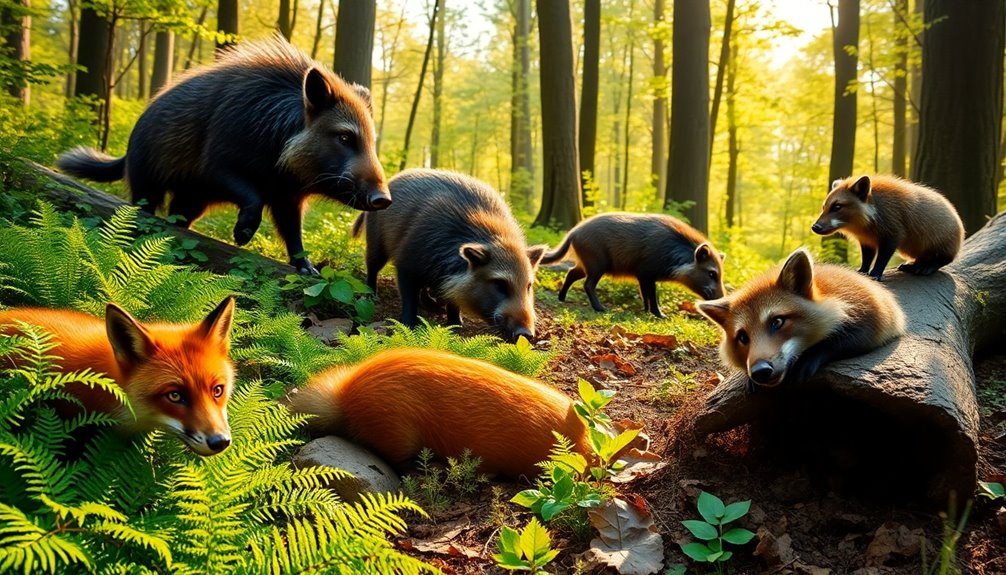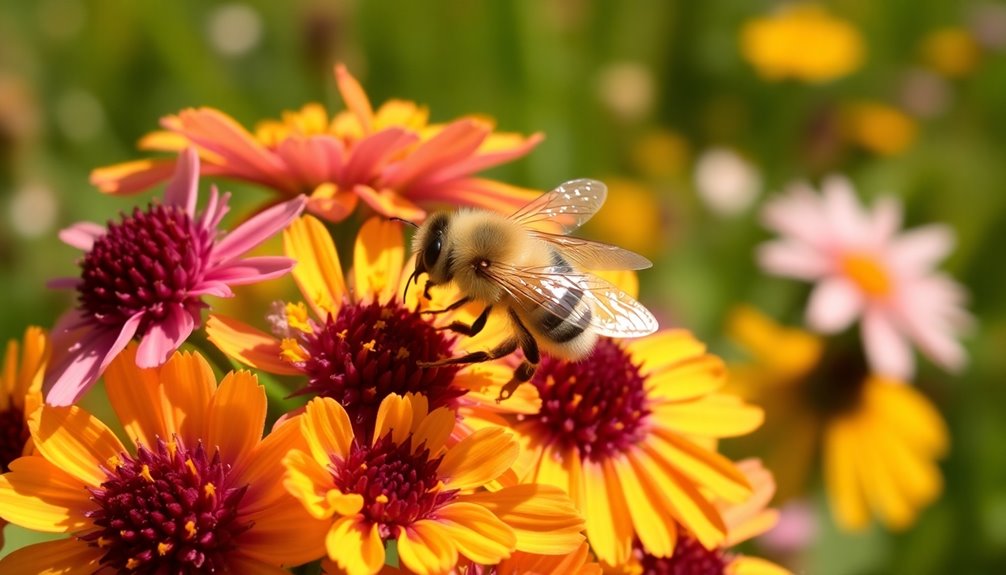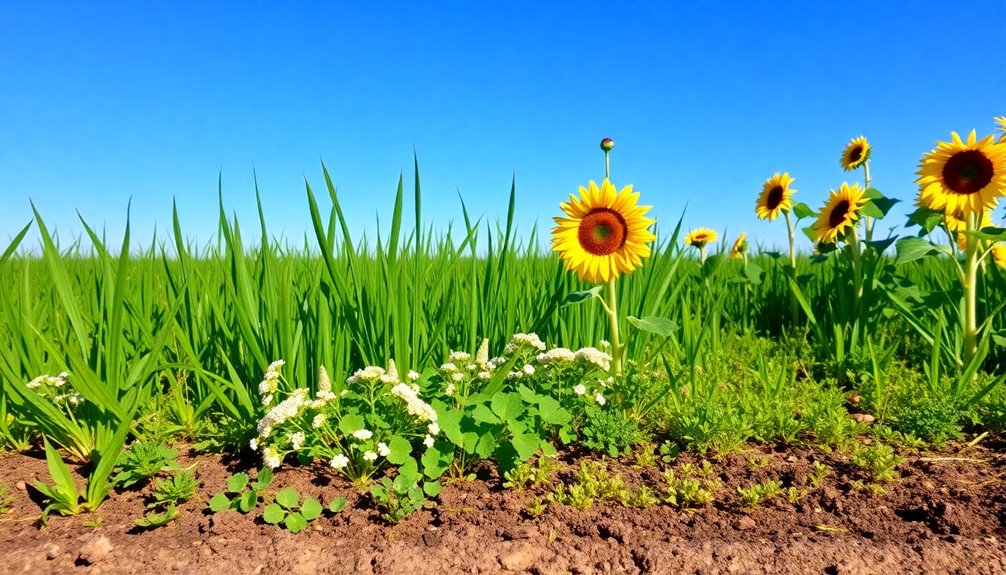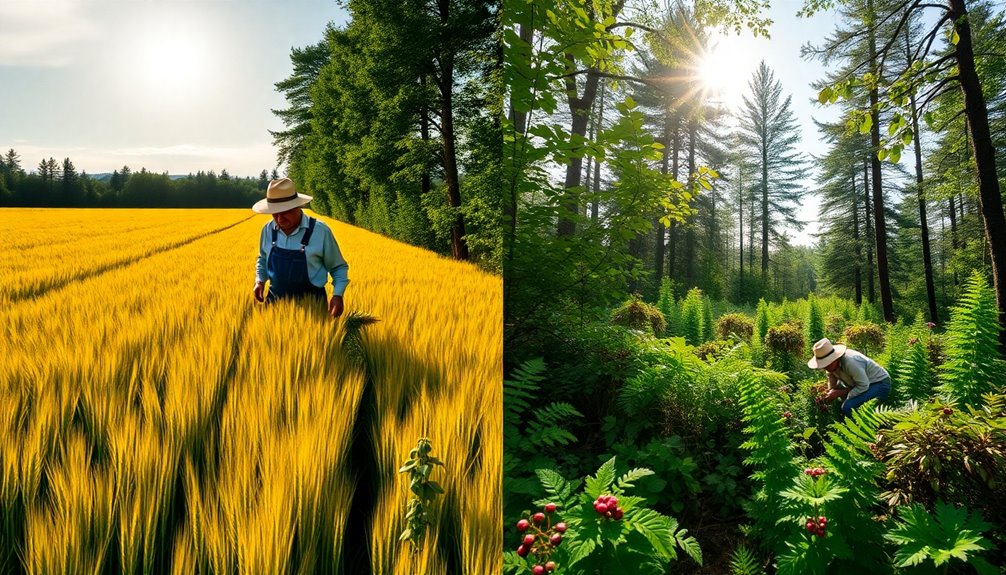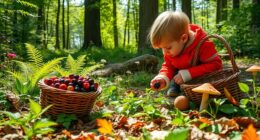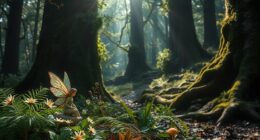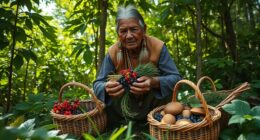Foraging animals are the wild diners of our planet, constantly seeking food in their natural habitats. They can be solitary, like elephant seals, or social, like dolphins and wild dogs. Each type uses unique strategies to find sustenance, whether through individual skills or teamwork. Their foraging behavior adjusts based on factors like predator presence and environmental conditions. These animals play essential roles in their ecosystems, influencing plant communities and animal populations. Understanding how they forage can help you appreciate their impact on biodiversity. Stick around, and you'll uncover more fascinating details about these remarkable creatures.
Key Takeaways
- Foraging animals search for food in natural habitats, playing a crucial role in their survival and reproduction.
- They can be classified as solitary foragers, hunting alone, or group foragers, relying on social cooperation.
- Foraging behaviors are influenced by factors such as predator presence, learning experiences, and environmental adaptations.
- Optimal Foraging Theory explains how animals make feeding decisions based on energy needs and food resource availability.
- The foraging activities of these animals significantly impact ecosystems by shaping plant communities and regulating prey populations.
Definition of Foraging Animals
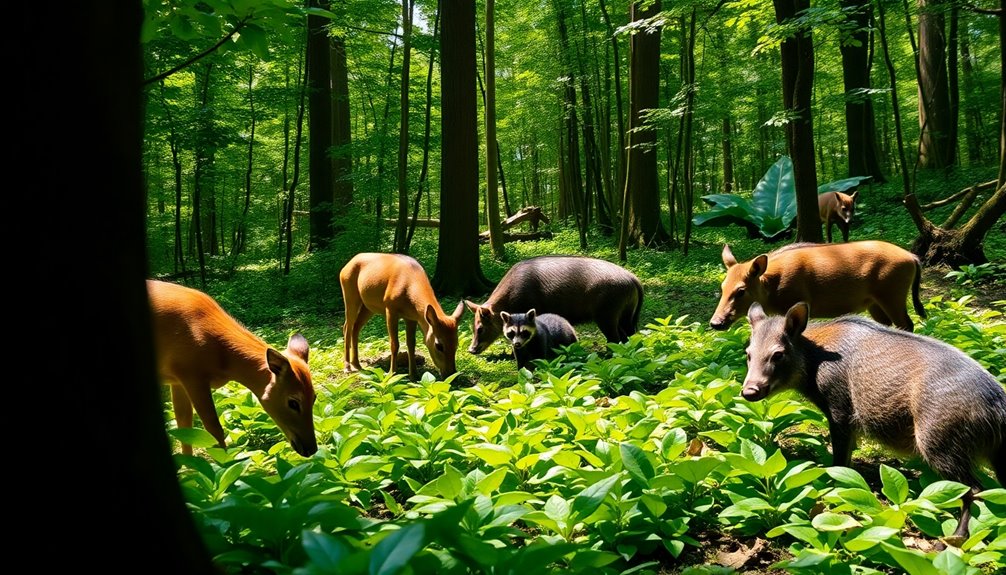
Foraging animals, actively searching for food in their natural habitats, are vital for their survival and reproduction. These wild animals engage in foraging behavior to locate and consume various resources, which differ based on their ecological niches.
You'll find solitary foragers like the Bolas spider, who hunt alone, alongside group foragers such as wild dogs and dolphins, who improve their efficiency through social cooperation.
Their foraging strategies are influenced by prey availability, predator presence, and environmental conditions, affecting their decision-making during food acquisition. By adapting their methods to these factors, they maximize their chances of survival.
For instance, herbivores like deer graze on vegetation, while carnivores like cougars hunt for prey, showcasing the diverse adaptations across species.
Understanding these animals' foraging patterns is essential for conservation efforts. Their activities greatly impact ecosystem dynamics, influencing not just their own survival, but also the overall health of their habitats.
Influences on Foraging Behavior
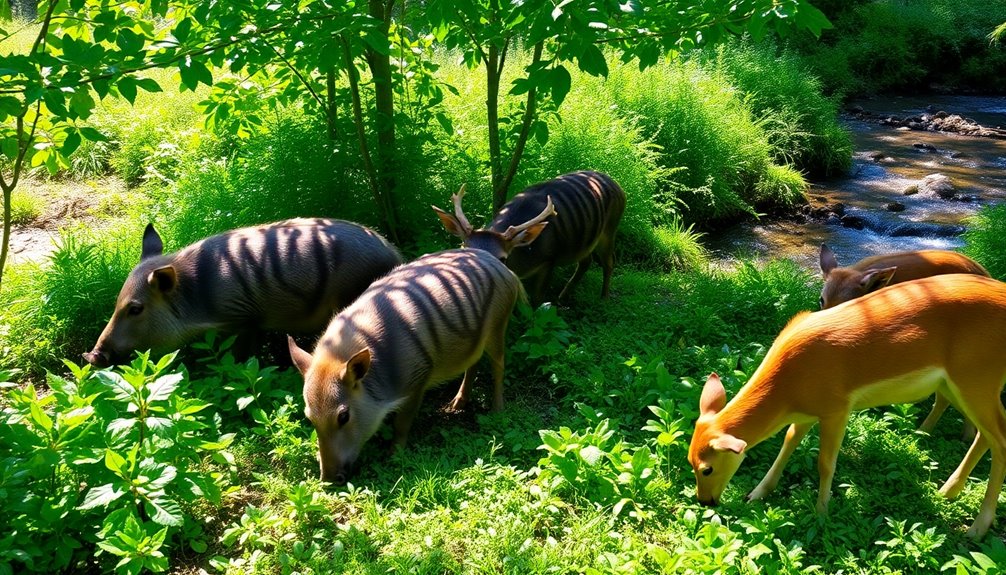
When you observe animals foraging, you'll notice how their behavior shifts in response to predators, learning experiences, and the threat of parasites.
These factors play an essential role in determining what, when, and where they choose to eat.
Understanding these influences can give you deeper insight into their survival strategies and adaptive behaviors.
Predator Presence Impact
Predators' looming presence can drastically change how animals hunt for food, forcing them to weigh the necessity of nourishment against the threat of being captured. This tension leads to significant shifts in foraging behavior, as animals adopt risk-averse strategies to enhance survival. You might notice that foragers often reduce their foraging time or select safer locations, demonstrating their keen awareness of predator risks.
To better understand these changes, consider the table below:
| Foraging Strategy | Impact on Foraging Behavior | Examples |
|---|---|---|
| Reduced Foraging Time | Less exposure to predators | Grazing at dawn or dusk |
| Altered Foraging Locations | Safer, less risky food sources | Choosing dense vegetation |
| Increased Vigilance | Time spent scanning for threats over eating | Antelope monitoring surroundings |
| Foraging in Groups | Leveraging safety in numbers | Fish schooling to avoid predation |
| Dietary Shifts | Avoiding accessible but risky food sources | Herbivores shifting to less palatable plants |
Learning and Adaptation
Animals constantly adapt their foraging behaviors based on their experiences and observations within their social groups. For young primates, learning experiences are essential; they watch and mimic the foraging techniques of their elders, which enhances their own foraging efficiency.
Spatio-temporal learning plays a key role here, as animals learn to associate specific times and locations with food availability, optimizing their search strategies.
Genetic factors also influence foraging adaptations, evident in honeybees that exhibit distinct foraging preferences linked to specific genes. This genetic predisposition helps them choose the best resources available in their environment.
When it comes to foraging decisions, animals often conduct a risk-benefit analysis, weighing the need for food against potential threats from predators. This vital evaluation leads to adaptive strategies that improve their chances of survival while foraging.
Parasitism and Food Choices
Foraging decisions are heavily influenced by the threat of parasitism, prompting many animals to avoid food sources that could heighten their risk of infection. This strategic approach shapes their foraging behavior and food selection.
Animals often learn to associate certain dietary choices with the presence of parasites, showcasing behavioral plasticity in their responses. For instance, primates and birds select specific plants known for their anti-parasitic properties, effectively practicing self-medication to boost their health and survival.
Research highlights that infected animals may alter their foraging patterns, consciously changing their diet and habitat use to reduce exposure to additional infections. A fascinating study on wild chimpanzees revealed that they preferentially choose certain fruit species that are associated with lower parasitic loads. This deliberate selection underscores the significant impact of parasitism on their dietary choices.
Types of Foraging Strategies
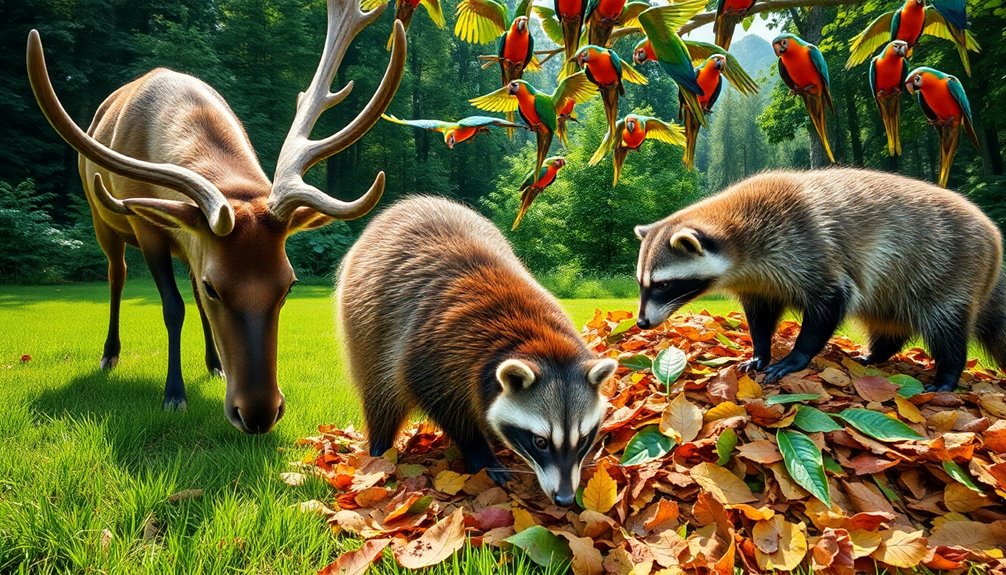
When you look at foraging strategies, you'll notice two main types: solitary and group foraging.
Solitary foragers rely on their individual skills, while group foragers benefit from teamwork, which can increase their chances of success.
Understanding these dynamics can give you insight into the fascinating ways animals secure their food.
Solitary Foraging Techniques
Solitary foraging techniques showcase how individual animals adeptly navigate their environments to find food without relying on others. This strategy is often observed in species like phocids, including elephant seals, where reduced competition thrives in resource-abundant environments. By foraging alone, these animals efficiently exploit specific prey types, which is exemplified by the South American harvester ant (Pogonomyrmex vermiculatus) that specializes in gathering seeds.
Solitary foragers exhibit unique adaptations, such as specialized hunting techniques and physical traits, enhancing their prey capture abilities. Environmental factors, like habitat structure and prey availability, greatly influence their foraging patterns, dictating when and where they hunt.
For instance, a solitary animal might adjust its approach based on the density of prey in a given area. Balancing energy expenditure with the benefits of food acquisition is vital for these foragers. This behavioral adjustment reflects their evolutionary adaptations to specific ecological niches, allowing them to thrive in diverse habitats.
Group Foraging Dynamics
Group foraging dynamics reveal how animals work together to enhance their chances of finding food. By engaging in group foraging, species like red harvester ants and chimpanzees demonstrate the power of cooperation in boosting resource discovery and hunting success. When animals forage in groups, they benefit from safety in numbers, which reduces individual predator risk and allows for more effective social foraging strategies.
Different species employ unique teamwork techniques to maximize their food intake. For instance, dolphins use coordinated hunting methods to capture prey, while African wild dogs rely on collective strategies to improve their success rate during hunts. These foraging strategies highlight the importance of collaboration, as the benefits often outweigh the costs—competition for resources and increased visibility to predators.
In contrast, solitary foraging can be advantageous in resource-rich environments, as seen in Bolas spiders. However, in most cases, group foraging enhances overall efficiency and increases the likelihood of survival.
Ultimately, the dynamics of group foraging illustrate how cooperation among animals not only improves their ability to find food but also strengthens their resilience against threats in their environments.
Cooperative Hunting Strategies
Cooperative hunting strategies showcase the remarkable ways animals collaborate to enhance their chances of capturing prey. By working together, species like African wild dogs and dolphins greatly improve their prey capture rates while reducing individual risk.
In chimpanzees, for instance, individuals coordinate efforts to chase and capture monkeys, demonstrating advanced social behaviors and effective communication.
These strategies often involve role specialization, where group members take on specific tasks, such as driving prey towards ambushers or lying in wait from concealed positions. This division of labor increases efficiency, allowing the group to execute complex hunting maneuvers that would be impossible for a solitary hunter.
Moreover, cooperative hunting fosters resource sharing, which is essential in resource-limited environments. By collaborating, animals strengthen social bonds and create a support system that benefits the entire group.
This social aspect enhances not only their hunting success but also the overall wellbeing of their community.
The Role of Optimal Foraging Theory
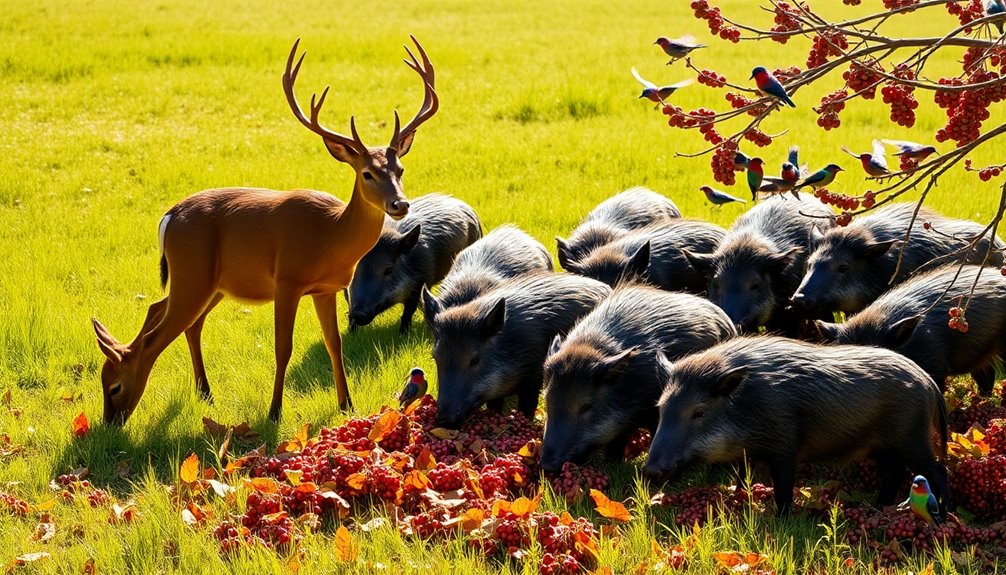
Ideal Foraging Theory (OFT) serves as an essential framework for understanding how animals make feeding decisions in their quest for energy. You'll find that OFT predicts animals refine their foraging behavior by selecting food sources that offer the highest caloric return relative to the energy spent on search time and handling time. By doing so, they maximize their net energy gain.
Key concepts of OFT include:
- Energy content in prey as a critical factor
- Handling time and search time influencing food choices
- Predation risk and competition affecting foraging decisions
- Empirical studies providing evidence supporting OFT predictions
These variables help researchers model how animals adapt their foraging behavior based on food availability.
For instance, empirical studies with birds and mammals show they frequently adjust their choices to balance energy gain with the inherent risks of their environment.
Although OFT provides a solid theoretical foundation, it's important to remember that real-world behaviors can deviate from these refined predictions due to external pressures.
Ultimately, understanding OFT enriches our appreciation of animal behaviors, informing both conservation efforts and practices in captive settings.
Foraging in Different Environments
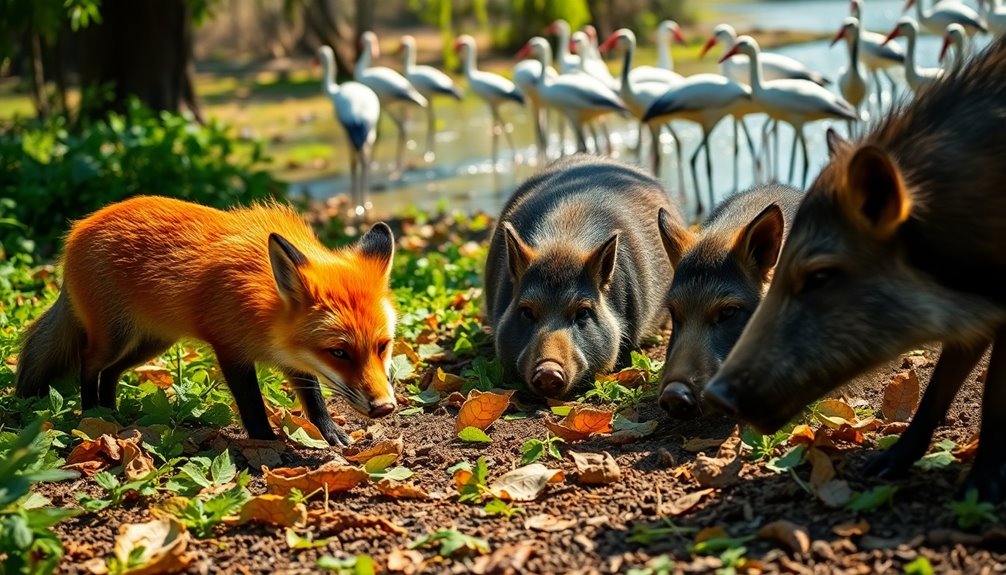
Many foraging animals exhibit remarkable adaptability to their environments, showcasing diverse strategies tailored to their specific habitats. In forests, bears forage for berries and nuts, while in marine ecosystems, sea otters plunge into kelp forests to hunt for sea urchins and crabs. Each species displays unique behaviors that allow them to thrive in their surroundings.
In desert areas, kangaroo rats have developed nocturnal foraging behaviors to escape the harsh daytime heat and conserve water. This adaptation highlights their ability to find food sources while avoiding extreme conditions.
On the other hand, urban foragers like raccoons and pigeons have cleverly adapted to human environments, rummaging through trash for scraps and demonstrating flexibility in their foraging strategies.
Grassland foragers, such as bison and prairie dogs, primarily graze on grasses and seeds, impacting vegetation dynamics as they move through their habitat.
Meanwhile, various fish species in aquatic environments utilize different depths and currents to locate prey, showcasing their adaptations.
Impact of Foraging on Ecosystems
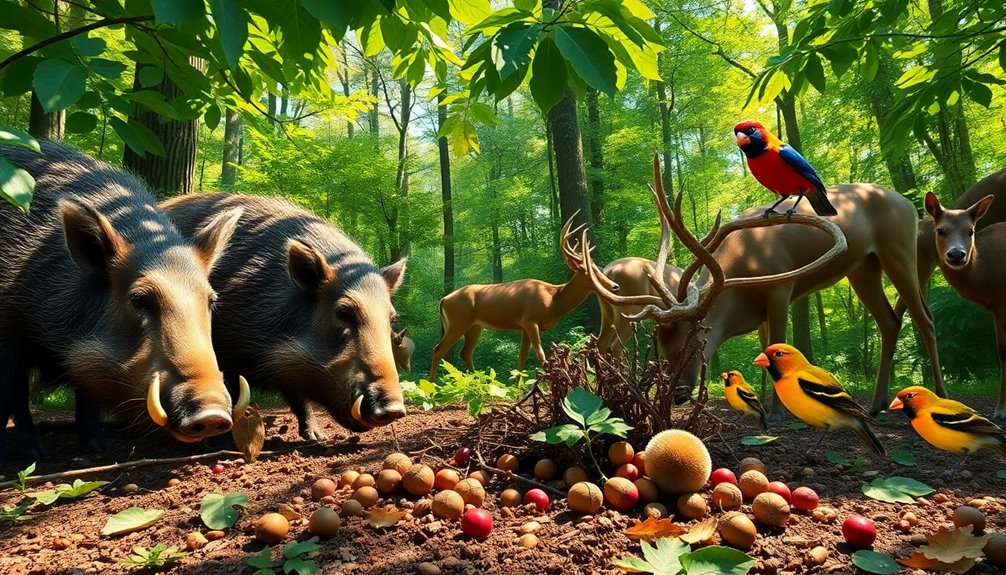
Foraging animals greatly influence their ecosystems, shaping plant communities and affecting overall biodiversity. Their foraging behavior directly impacts plant community dynamics by promoting the growth of less competitive species.
However, when populations of herbivores, like deer and rabbits, overgraze, they disrupt plant regeneration, leading to soil erosion and altering habitat structure.
Here are some key effects of foraging on ecosystems:
- Seed dispersal: Omnivorous animals, such as raccoons and bears, play a significant role in spreading seeds, enhancing forest regeneration.
- Predator-prey dynamics: The foraging patterns of predators help regulate prey populations, affecting vegetation structure and composition.
- Invasive species: Species like the three-spined stickleback can outcompete native foragers, disrupting local food webs and fisheries.
- Biodiversity promotion: Selective feeding by foragers allows more diverse plant communities to flourish, maintaining ecosystem health. Additionally, foraging practices, such as those highlighted in sustainable harvesting practices, can benefit local wildlife by ensuring that food sources remain plentiful.
Understanding these interactions is essential for managing biodiversity and ecosystem stability. The balance of foraging behaviors among species is important for sustaining healthy environments and supporting diverse wildlife.
Frequently Asked Questions
What Is Foraging Animals?
Foraging animals actively search for and gather food from their surroundings.
You'll find herbivores like deer munching on vegetation, while carnivores like wolves hunt for prey.
Some animals forage alone, but others, such as dolphins and chimpanzees, work together to improve their chances of finding food.
They've adapted their foraging strategies based on environmental factors, like the presence of predators, ensuring they maximize their energy intake while minimizing risks.
What Is an Example of Foraging?
Imagine a clever red fox, weaving through both bustling streets and quiet fields, searching for its next meal.
This furry forager employs clever tricks, caching tasty finds and skillfully hunting small mammals.
By adapting to its surroundings, the fox thrives wherever it roams.
Whether it's a chilly night or a sunny afternoon, this nimble creature showcases the art of foraging, turning each hunt into a delightful adventure for itself.
What Is Wild Foraging?
Wild foraging is the practice of searching for and gathering naturally occurring food resources in their habitats.
When you forage, you're not just collecting plants and mushrooms; you're connecting with nature and learning about local ecosystems.
It's important to know which species are safe to eat and to follow sustainable practices, like taking only a small percentage, to keep populations healthy.
This activity not only nourishes you but also fosters community engagement.
What Are the Different Types of Foraging Behavior in Animals?
You'll find that animals exhibit two primary types of foraging behavior: solitary and group foraging.
When foraging alone, like elephant seals, they efficiently hunt in resource-rich areas.
In contrast, group foraging involves species such as red harvester ants, where collaboration enhances food acquisition and safety.
These behaviors also include various strategies like ambush predation and scavenging, allowing animals to adapt based on their environment and past experiences for ideal food gathering.
Conclusion
In exploring the world of foraging animals, you've uncovered a fascinating tapestry of behaviors and strategies that shape our ecosystems. These wild diners, gracefully maneuvering their environments, embody the delicate balance of nature's banquet. Their foraging not only sustains them but also nurtures the intricate web of life surrounding them. As you reflect on these remarkable creatures, remember that their quest for sustenance is a beautiful dance of survival, enriching our planet in ways we often overlook.

